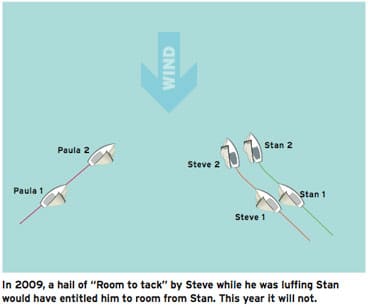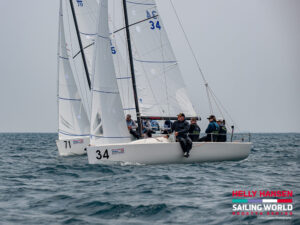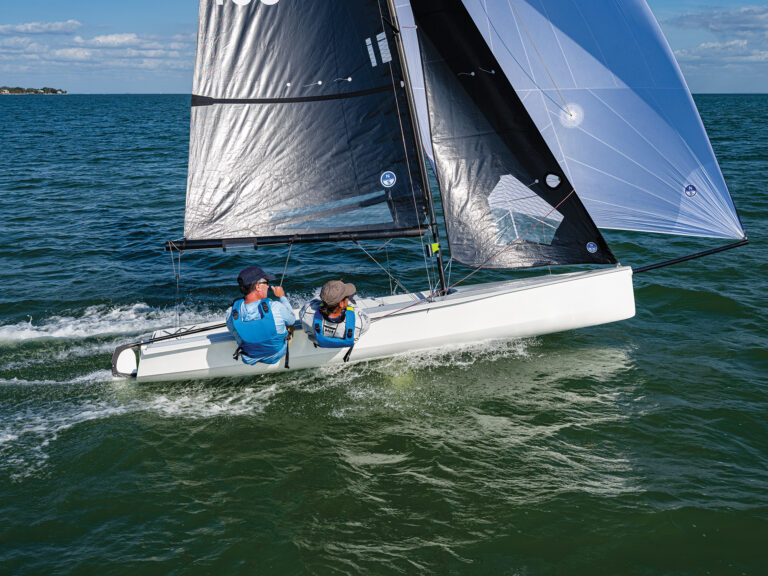
Dave Norton| | A revised set of racing rules is published every four years, and those new rules take effect on January 1 of the year following the Olympic Regatta. It’s the International Sailing Federation’s policy to avoid changing any racing rules midway through a rulebook’s four-year cycle, but on Jan. 1, 2010, ISAF will change several rules one year into the 2009-2012 rulebook cycle.
At its annual November meetings, ISAF made two changes in the Part 2 rules and related definitions-the rules that most interest sailors. In my opinion, these changes were made only because of the increased interest in team racing and the instantaneous worldwide communications made possible by the Internet. Team racers are always on the prowl for new tactics, and a new rulebook is grist for their mill. These days, when they find a new tactic they trumpet it to their peers instantly over the Internet. These two changes are largely attributable to those two factors.
The Part 2 rule that is changed is Rule 18.2(c). In 2009, Rule 18.2(b) was “switched off” if either the boat entitled to mark-room or the boat required to give mark-room turned past head to wind. Now a turn past head to wind by the boat required to give mark-room will no longer turn off Rule 18.2(b).
The team-racing tactic that led to the change is shown in the first diagram. In light wind, at a leeward mark to be left to port, Able, Baker, and Charlie were all overlapped when they reached the zone and all three were clear ahead of Delta. Therefore, under Rule 18.2(b) Delta was required to give the other three boats mark-room. In 2009, if Delta made a quick tack-as shown at Positions 2, 3, and 4-Rule 18.2(b) switched off. At Position 5, Delta had an inside overlap on Baker and Charlie and, because 18.2(b) no longer applied, Delta was entitled to mark-room under Rule 18.2(a) from them. What’s more, because Delta’s inside overlap was obtained as she passed head to wind and was not obtained from clear astern, Baker and Charlie had to give Delta mark-room even if, having been surprised by her spin, they were unable to do so (see Rule 18.2(e)).
Delta’s tactic is a potentially dangerous one. Imagine fast keelboats with sprits, and suppose there was a gaggle of boats at the mark in addition to Able, Baker, and Charlie. There could well be damage if Delta surprised the boats ahead and then loudly claimed mark-room when it was too late for the boats ahead to provide mark-room. In past years, if someone discovered such an esoteric tactic, it would probably have taken quite a while to make its way into common knowledge, and, in the meantime, ISAF could have changed the rule. Once team racers caught on to this tactic, its usage spread rapidly. The InterCollegiate Sailing Association thought the tactic so undesirable that it obtained US SAILING’s permission to ban the tactic in collegiate racing in 2009. Late in 2009, it was reported that the tactic had been used in fleet racing as well. ISAF thought the risk of damage was high enough to warrant an urgent and immediate change to Rule 18.2(c). Under the new version of that rule, Delta would, despite her tack, continue to be obligated to give the boats ahead of her mark-room and she herself would not be entitled to mark-room.
The second change that affects tactics is the change in the definition Obstruction. The change is that a boat is no longer an obstruction to two other boats when both of them are required to give the first boat room or mark-room. Careful study of the effect of this change indicates that it is helpful in three ways. It simplifies a complex definition; it simplifies the application of Rules 18 and 19 when three or more boats are rounding a mark together; and it prohibits a game-changing tactic recently discovered by the team-racing community. The discovery of this tactic was one important reason this change was made immediately.

Dave Norton| |
The second diagram shows a situation in which that tactic could be applied. On a beat and well away from all marks, Steve and Stan are overlapped on starboard tack and on a collision course with Paula, on port tack. Steve wants to tack to leeward of Paula, but he can’t tack because Stan is blocking him from doing so. Under the 2009 definition of obstruction, at Position 1 Paula was not an obstruction to Steve and Stan because she did not have right of way over them and they were not required to give her room or mark-room. Therefore, at Position 1 Steve could not use Rule 20.1 to hail for room to tack. What team racers discovered was this: If Steve luffed Stan and Stan luffed in response-under the 2009 definition-Paula became an obstruction because both Steve and Stan were then right-of-way boats changing course and therefore obligated to give Paula room to keep clear under Rule 16.1. So, in 2009, if Steve hailed, “room to tack” while he was luffing Stan, then Stan would have been required by Rule 20.1 to tack and give Steve room to tack to leeward of Paula.
Rule 20 is essentially a safety rule, and was not intended to be used in this situation. Under the new definition, Paula doesn’t become an obstruction when Steve and Stan luff, and Steve isn’t permitted to use Rule 20.1 to force Stan to give him room to tack.
ISAF added to the definition Party to correct some previously unnoticed, and rather glaring, omissions in the definition. For example, in 2009, suppose, after a race committee witnessed a jet ski hit a boat sailed by Harry, causing damage, it asked the protest committee to give Harry redress (see rules 60.2(b) and 62.1(b)). Only parties are allowed to be present while testimony is given, to give their own testimony, and to call and question witnesses. Under the 2009 definition, Harry would not be a party because he had not himself requested redress, and the race committee would not be a party because the basis for the request for redress was Rule 62.1(b) and not 62.1(a). Therefore, it would have been a very strange hearing with no parties present.
The revised definition will have an important impact on certain controversial redress hearings. Suppose a boat requests redress alleging that a mark was dragging its anchor while the fleet was rounding it. Obviously, if the allegation were true, many boats might well have been affected. The new definition allows the protest committee, under Rule 60.3(b), to consider redress for the entire fleet and invite all boats in the race, if they wish, to send a crewmember to the hearing and enjoy all the rights of a party. Such a procedure could avoid the chain of successive redress hearings that are often triggered in such situations.
E-mail for Dick Rose may be sent to [email protected]









